Moving to Florida brings that endless sunshine and beautiful weather, but you’re also signing up for hurricane season from June through November. New Florida homeowners can feel a bit overwhelmed their first time around—what do you even do, and when should you start?
Hurricane prep isn’t something you want to leave until the last minute. If you wait until a storm’s on the radar, you’ll be fighting crowds for supplies and services.
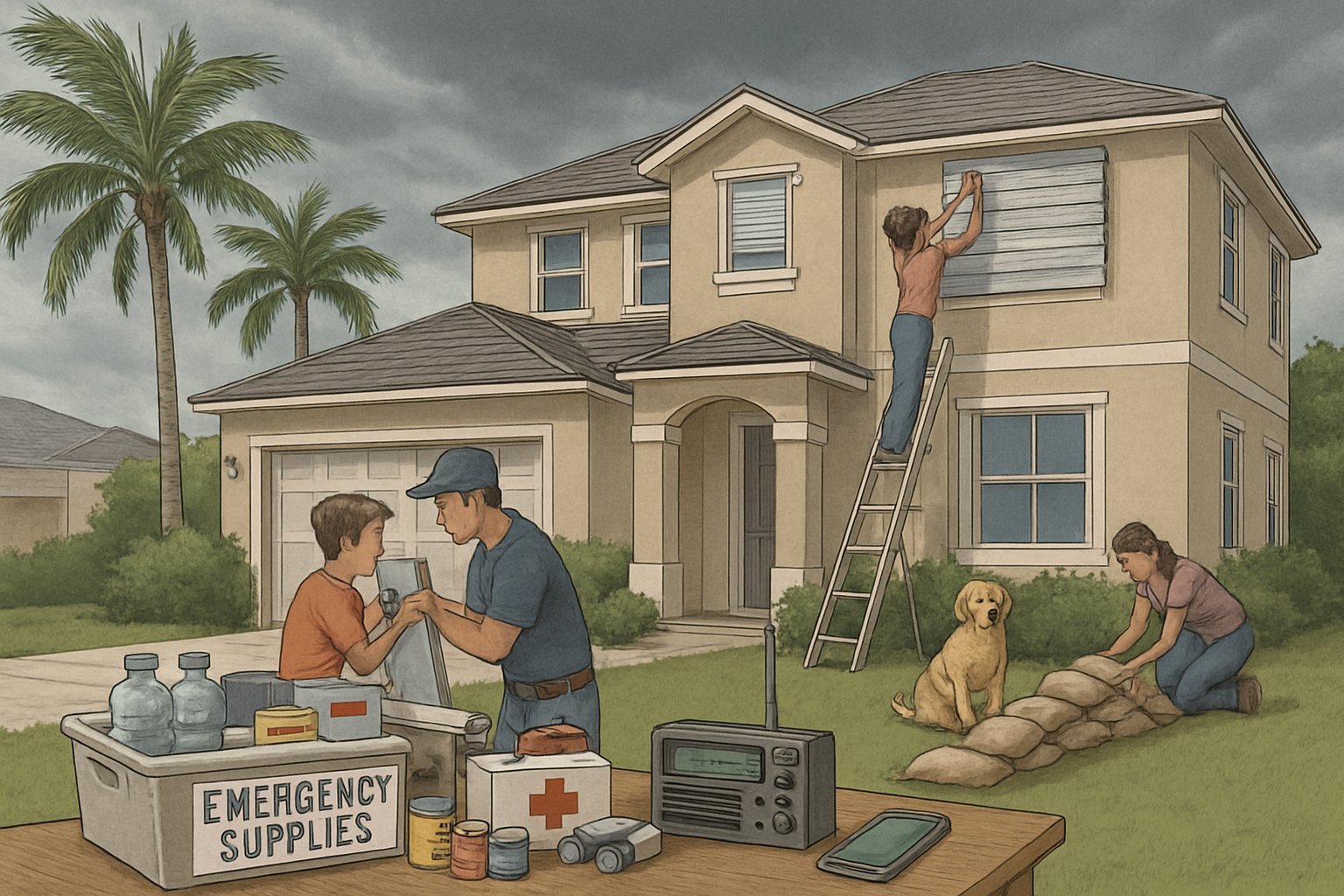
Peak hurricane season in Florida falls between August and October, so getting ready early just makes sense. A prepared home can save you a fortune in damage and spare you a lot of stress if things get rough.
Smart preparation means securing your home’s exterior, stocking up on emergency supplies, understanding your insurance, and having a solid evacuation plan.
Need a Home Fix – Emergency or Routine?
From leaks and no-heat nights to simple tune-ups, our 24/7 hotline connects you with trusted local pros in minutes.
Key Takeaways
- Start hurricane prep well before the season begins so you’re not scrambling for supplies
- Secure your home’s exterior: trim trees, clean gutters, test hurricane protection systems
- Assemble emergency supply kits—water, food, meds, documents—and set up a family evacuation plan
Understanding Florida’s Hurricane Risks

Florida has the highest hurricane risk in the U.S., thanks to its warm coastal waters and location. The state’s unique geography means homeowners face several types of storm threats.
When Hurricane Season Starts and Ends
Florida’s hurricane season officially runs from June 1 to November 30. But honestly, storms can pop up earlier or later—sometimes May, sometimes even December.
Storm activity peaks between August and October, when the water’s warmest and storms get a little too comfortable. The National Hurricane Center tracks storms and issues warnings for Florida’s coastlines.
Start prepping well before June. Once a storm shows up on the weather map, supplies vanish and contractors are impossible to reach.
Early season storms can catch people off guard. Late season storms? Just as risky, especially if you’ve let your guard down.
Types of Storm Threats for Homeowners
Florida homeowners mostly worry about three things: high winds, storm surge, and flooding from heavy rain. Each one brings its own headaches.
High Winds can blast past 150 mph in big hurricanes, turning lawn chairs and tree branches into projectiles and even ripping off roofs.
Storm Surge is when hurricane winds shove ocean water inland. Sometimes, that wall of water reaches 20 feet or more along the coast.
Heavy Rainfall causes flooding inland. Hurricanes can dump 10–20 inches of rain in just a few hours, overwhelming drains and ditches.
Hurricanes can also spin up tornadoes, sometimes far from the storm’s center. These cause even more wind damage.
Flying debris is a huge problem. Patio furniture, branches, and random objects become missiles in hurricane winds.
How Flood Zones Affect Risk
Flood zones decide your property’s flood risk and insurance requirements. FEMA draws these maps based on past flood data.
High-risk zones (A or V) have a 1% annual chance of flooding. If you have a mortgage here, you’ll need flood insurance.
Moderate-risk zones (B, C, or X) are less likely to flood but aren’t risk-free during big storms.
Coastal V zones face the worst storm surge risk and have stricter building standards.
Insurance is way pricier in high-risk zones. Moderate-risk areas pay less, but it’s still worth checking your rates.
Double-check your flood zone before hurricane season. FEMA updates maps, so your designation can change.
Essential Home Safety Preparations
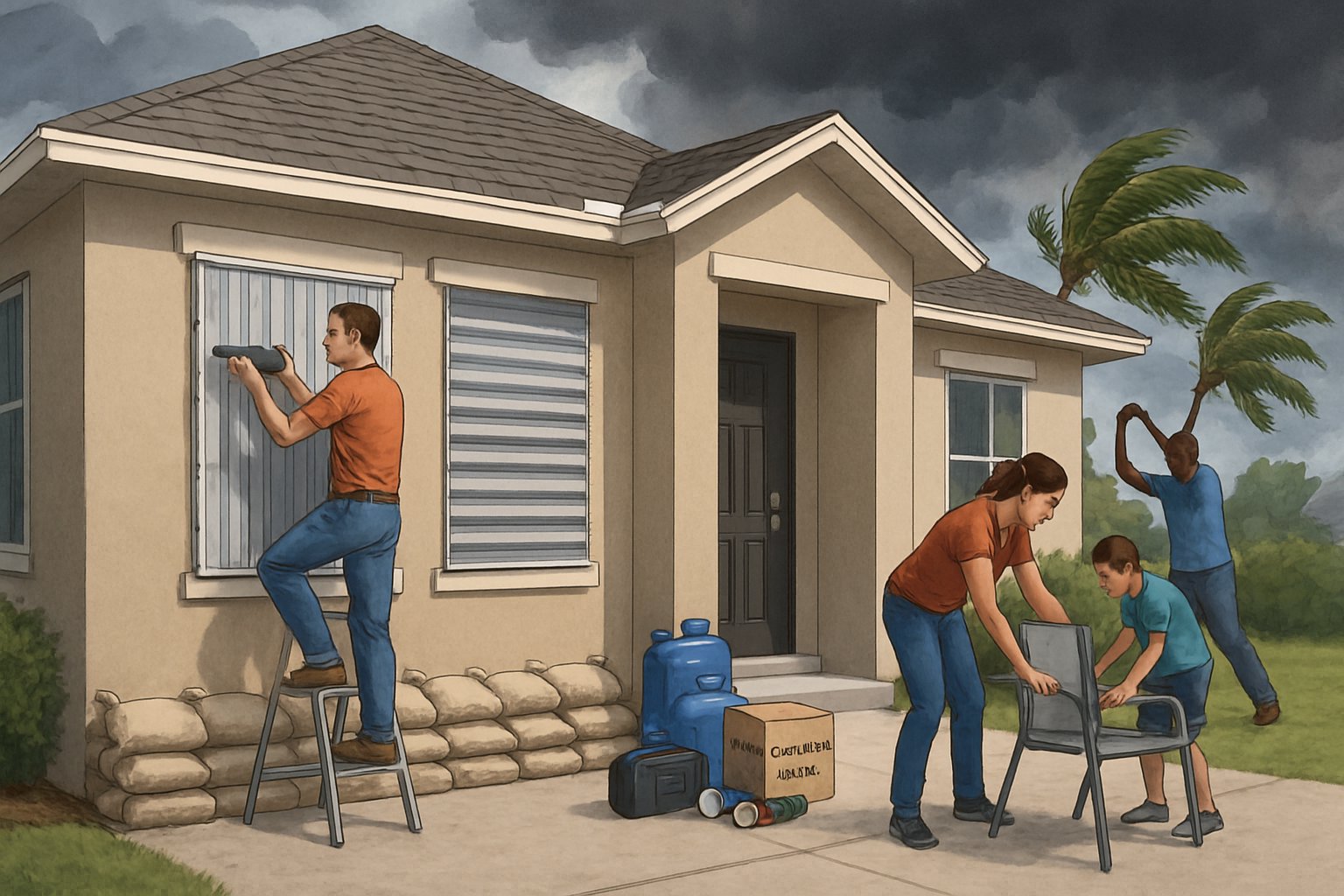
Protecting your home’s structure and yard is the first step in hurricane prep. Focus on the weak spots—windows, doors, roofs, and landscaping that can get dangerous in high winds.
Inspecting and Securing Your Roof
Check your roof twice a year for loose or damaged shingles, tiles, or panels. Even one missing shingle can let wind and water in during a hurricane.
Key inspection spots:
- Cracked, curled, or missing shingles or tiles
- Flashing around chimneys, vents, skylights
- Gutters and downspouts—make sure they’re attached
- Soffit and fascia boards for rot or damage
Professional roofers can spot problems you might miss. They’ll replace damaged materials and make sure everything’s up to Florida code.
Check roof-mounted gear like satellite dishes and solar panels. Anchor anything that could fly off in high winds.
Keep gutters and downspouts clear to prevent water backup. Clogged drains can make your roof collapse if water pools up.
Installing Hurricane Shutters and Impact Windows
Hurricane shutters are the most affordable way to protect windows. Plywood works if you’re on a budget, but metal accordion or roll-down shutters are easier and tougher.
Shutter options, from basic to best:
- Plywood: Cheap, but you’ve got to put them up yourself
- Accordion: Mid-priced, quicker to deploy
- Roll-down: Expensive, but you can use a remote
Impact windows skip the need for shutters. They’re made with laminated glass that won’t shatter, and as a bonus, they cut noise and save energy year-round.
Measure all your windows and sliding doors before hurricane season. Pre-cut plywood saves time when a storm’s coming—just label and store it somewhere dry.
Let pros handle installation for shutters and impact windows. Poorly installed shutters can fail or even damage your walls in a storm.
Garage Door and Entry Reinforcement
Garage doors are usually the weakest link in a hurricane. Wind can bow them in and wreck your roof.
Ways to reinforce garage doors:
- Add horizontal braces across the panels
- Install vertical support posts in the center
- Upgrade to hurricane-rated doors
- Reinforce tracks and mounting hardware
Entry doors need strong locks and reinforced frames. Swap out hollow-core doors for solid wood or metal. Anchor frames to wall studs with long screws or bolts.
Windows near doors are a security risk. Install impact glass or shutters to keep out both wind and would-be intruders.
Replace worn weather stripping around doors and windows. It helps keep out wind-driven rain and water leaks.
Protecting Outdoor Spaces and Landscaping
Anything loose outside can become a projectile. Secure or store patio furniture, grills, planters—basically, anything that could fly away.
Secure these items first:
- Patio furniture and umbrellas
- Trash and recycling bins
- Garden tools and equipment
- Pool toys and accessories
Trim tree branches that could hit your house or power lines. Remove dead or weak limbs. If you’ve got big trees, consider hiring a pro to check their health.
Don’t plant new trees close to your house or power lines. For mature trees, cabling or bracing can help prevent splitting in strong winds.
Pool areas need special care. Store loose gear somewhere safe, and check pool screens or enclosures for damage or weak spots.
Building an Emergency Supplies Kit
You’ll need enough supplies to last seven days without power or a trip to the store. Stock up on food, water, power sources, medical stuff, and important documents.
Stocking Non-Perishable Food and Water
Water: Plan for one gallon per person per day for at least a week. For a family of four, that’s 28 gallons.
Store water in clean containers, out of the sun. Swap it out every six months so it stays fresh.
Non-perishable food should be stuff you don’t have to cook or refrigerate. Pick foods your family will actually eat—no point stocking up on stuff nobody likes.
Good food options:
- Canned meats, fruits, veggies
- Peanut butter and crackers
- Granola bars and nuts
- Dried fruit and cereal
- Baby food and formula if you need it
Keep a manual can opener handy. Check expiration dates and rotate your stock every six months.
Power Banks and Lighting Essentials
Power banks keep your phone and devices charged when the power’s out. Look for ones with at least 20,000 mAh—more is better.
Charge them up every month and test before hurricane season starts.
Lighting: LED flashlights, battery lanterns, and headlamps are your friends. Skip the candles—they’re a fire risk in storms.
Other key items:
- Battery-powered or hand-crank radio
- Extra batteries (AA, AAA, D, whatever you use most)
- Solar phone chargers as a backup
- LED flashlight for everyone
- Portable lanterns for lighting up rooms
First Aid Kit and Prescription Medications
A first aid kit covers basic injuries if medical help isn’t available. Pre-made kits are fine, but check what’s inside before hurricane season.
Must-have supplies: bandages, antiseptic wipes, painkillers, medical tape. Add anything your family needs specifically.
Prescription meds need extra planning. Refill 30-day supplies before June 1 every year.
Store meds in waterproof containers with the labels. Keep a written list of all prescriptions, doses, and doctors’ names.
If a storm is coming, call your doctor early for refills. Pharmacies might close or lose power for days.
Storing Important Documents Safely
Document protection really matters when flooding or wind might destroy your most important papers. Make copies of everything, and stash them in different places—you never know when you’ll need a backup.
Essential documents include:
- Insurance policies (home, flood, auto)
- Identification cards and passports
- Bank account and credit card information
- Medical records and prescriptions
- Property deeds and mortgage papers
Use waterproof containers or just seal things up in plastic bags for the originals. Save digital copies to the cloud or on USB drives you keep somewhere else—don’t just trust one spot.
Take photos of your property and stuff inside before storms hit. This makes insurance claims way less of a headache.
Insurance and Financial Protection
Florida homeowners really need to get their insurance coverage and finances sorted before hurricane season. Most policies have weird deductibles and gaps that can catch you off guard after a storm.
Reviewing Homeowners and Flood Insurance
Standard homeowners insurance doesn’t cover flood damage caused by hurricanes. If you want protection from storm surge and rising water, you’ll need separate flood insurance in Florida.
The National Flood Insurance Program (NFIP) usually makes you wait 30 days after buying a policy. Private flood insurers sometimes skip the wait, but still need time to process things.
Key flood insurance facts:
- NFIP policies cost less in moderate and low-risk flood zones
- Private carriers may offer higher coverage limits
- You have to buy either option before storms get close
Check your flood zone on FEMA maps. If you’re in a high-risk area, you’ll need higher coverage—no way around it.
Once the National Weather Service issues a hurricane or tropical storm watch, insurance companies stop writing new policies. You really don’t want to wait until the last minute.
Homeowners policies cover wind damage, but usually with separate deductibles. Double-check that your wind coverage actually matches what it would cost to rebuild your house now, not five years ago.
Taking Inventory and Documenting Property
If you want your insurance claim to go smoothly, document your stuff before hurricane season. Don’t put it off—trust me, it’s worth it.
Essential documentation steps:
- Take photos or videos of every room
- Record serial numbers for electronics and appliances
- Save receipts for valuable items in digital format
- Store copies in cloud storage and physical safes
Include everything—furniture, clothes, personal items. Open closets and drawers; it all adds up fast.
Digital backups save you if the originals get ruined. Scan insurance policies, deeds, IDs, and medical records to encrypted online storage—better safe than sorry.
Updated appraisals help with jewelry, art, and collectibles. Standard coverage might not be enough for those without extra endorsements.
Understanding Deductibles and Policy Details
Florida policies often have hurricane deductibles that work as a percentage of your dwelling coverage, not just a flat dollar amount. It’s easy to overlook how much that adds up to.
These hurricane deductibles usually range from 2% to 5% of Coverage A. For a $400,000 home, you’d pay between $8,000 and $20,000 out of pocket before insurance kicks in. Ouch.
Coverage types to review:
| Coverage | What It Covers | Check For |
|---|---|---|
| Dwelling | House structure | Current rebuilding costs |
| Personal Property | Belongings inside | Replacement cost vs. actual cash value |
| Additional Living Expenses | Temporary housing | 20-30% of dwelling coverage typical |
| Other Structures | Sheds, fences, detached garages | Recent additions included |
Your policy declarations page spells out deductible amounts and coverage limits. If anything’s unclear, call your insurance agent before a storm is even on the radar.
Some policies have separate windstorm deductibles that kick in at different wind speeds than hurricane deductibles. Knowing these details helps you plan for whatever comes your way.
Creating an Evacuation Plan
A solid evacuation plan helps families get out fast when a storm’s coming. You need to know your route, gather supplies, and figure out what to do with your pets before hurricane season starts.
Identifying Local Evacuation Routes
Florida residents should know their evacuation zone and which routes to take. Every county puts out evacuation maps that break zones down by flood risk and storm surge.
Call your local emergency management office to find your specific zone. Zones run from A (highest risk) to E (lowest). If you’re in A or B, expect to be told to leave first.
Key steps for route planning:
- Visit your county’s emergency management website
- Download current evacuation maps
- Identify your home’s evacuation zone
- Note the recommended route from your neighborhood
Try driving your evacuation route on a calm day. You’ll spot construction, narrow roads, or anything else that could slow you down later.
Evacuation routes can change as new maps come out, so check for updates every year before June.
Planning Your Evacuation Logistics
Pick a destination close to home—there’s no need to drive across the state. Usually, just going a few dozen miles inland is enough.
Choose your destination in this order:
- Friends or family in the same county
- Friends or family in nearby inland counties
- Hotels or motels within 50 miles
- Public shelters as a last option
Book hotels before you leave, because they fill up fast once evacuation orders go out. Call early for the best shot at a room.
Fill up your gas tank before you hit the road. Gas stations on evacuation routes usually run out or lose power during storms.
Pack your documents in waterproof bags—bring your insurance papers, IDs, bank info, and medical records. Keep some cash, too, since ATMs might be down.
Leave as soon as you get the order. Even a short delay can mean hours more in traffic.
Caring for Pets and Family Needs
Most public shelters won’t let you bring pets unless they’re service animals. If you have pets, you’ll need a separate plan for them.
Pet evacuation options:
- Pet-friendly hotels (book early!)
- Friends or family who can take your pets
- Pet-friendly shelters (but spots are limited)
- Boarding facilities outside evacuation zones
Bring pet food, water, meds, carriers, and something comforting from home. Keep their vaccination records and a recent photo, just in case.
Families with special medical needs should pack at least a week’s worth of prescriptions. Find out where the closest hospital or urgent care is near your evacuation spot.
If you have elderly or mobility-challenged family members, assign someone to help them get to the car and carry their stuff.
Pack a disaster supply kit for wherever you’re going. You’ll want water, non-perishable food, flashlights, batteries, and a first aid kit. It’s not fun, but being prepared beats being stuck without basics.
Final Preparations Before a Hurricane Arrives
When a hurricane watch or warning pops up, it’s time to move from slow prep to urgent action. These last hours are for locking down your home, double-checking supplies, and watching official weather updates like a hawk.
Preparing Your Home for Departure
If flooding’s at all possible, move everything you can to higher floors. Ground floors usually take the brunt of water damage from storm surge or heavy rain.
Secure important documents in waterproof containers or move them upstairs. Stuff like birth certificates, insurance papers, and medical records should stay dry, no matter what.
Fill bathtubs and big containers with clean water before the storm. City water systems often go down, and you might need that water for days.
Turn off the main breaker if you think flooding will hit. Never mess with electrical stuff if you’re standing in water. If you’re leaving, shut off the gas at the meter, too.
Charge all your devices—phones, tablets, backup batteries. Cell towers may go down, but you’ll want your devices ready for emergency alerts when service comes back.
Last-Minute Supply and Safety Checks
Stock enough supplies to last at least a week without power or outside help. Florida storms can isolate neighborhoods longer than you’d expect.
Water storage should cover one gallon per person per day. For a family of four, that’s 28 gallons. Top off any extra containers you can find.
Food supplies should be things like canned goods, peanut butter, crackers—anything you don’t have to cook. And don’t forget a manual can opener.
Test your flashlights and battery radios one last time. Swap out weak batteries. Stash lights in different rooms, since people often get separated during long storms.
Gather medical supplies and prescriptions into one easy-to-grab bag. If you have elderly relatives or little kids, make sure you’ve got what they need, too.
Staying Informed With Reliable Updates
The National Hurricane Center gives the best storm tracking and intensity forecasts. Local weather services break it down for your county or city.
Check official sources every few hours—storm paths shift fast. Social media can be a mess of rumors when storms are active.
County emergency management offices issue evacuation orders and shelter info. Follow your local evacuation zone; don’t try to guess if it’s safe to stay.
Weather radios keep broadcasting alerts even if regular stations go dark. Tune into NOAA Weather Radio for the latest updates.
Have backup ways to communicate since cell service can disappear. Pick an out-of-state contact who can relay info between family members if you get separated.
Frequently Asked Questions
Florida homeowners need the right supplies, home reinforcements, and solid action plans to get through hurricane season. Knowing your evacuation zone, prepping for power outages, and keeping emergency plans updated can really make the difference.
What items should be included in a basic hurricane preparedness kit for Florida homeowners?
Start with one gallon of water per person per day for a week. You’ll need it for drinking, cooking, and cleaning if the water goes out.
Non-perishable food is your friend—canned goods, protein bars, snacks. No fridge or stove needed. Remember, a manual can opener is a must.
Medical supplies should cover a week’s worth of prescriptions and a good first-aid kit. Pharmacies might stay closed for days after a storm.
Charged phones, power banks, battery radios, flashlights, and extra batteries help you stay connected and informed. You don’t want to be in the dark, literally or figuratively.
Store important documents in waterproof containers. Things like insurance policies, IDs, bank info, and home inventories will help you recover faster after the storm.
How can Florida homeowners reinforce their homes to withstand hurricane damage?
Storm shutters or hurricane panels give windows the best shot at surviving a storm. Honestly, taping windows doesn’t help and can actually make things worse.
Garage doors need extra care since they’re weak spots in high winds. Add braces or swap in hurricane-rated doors to keep them from failing.
Trim your trees and clear out gutters to cut down on flying debris and water damage. Loose branches can turn into missiles fast when a hurricane hits.
Bring in or secure all that outdoor furniture, decorations, and equipment. If you leave them out, they’ll fly around and smash things up.
If you’ve got a pool, lower the water a bit, but don’t drain it all the way. The water’s weight actually helps protect the pool shell from wind damage.
What are the critical steps to take when a hurricane watch or warning is issued in Florida?
Once there’s a hurricane watch, you can’t change your insurance policy—no tweaking coverage or adding anything new. That window closes fast.
It’s a mad dash for final prep: fill up the gas tank, grab some cash, and pick up last-minute supplies. Gas stations and ATMs can go dark for days.
Time to activate your communication plan. Make sure everyone in the family knows how to reach each other and where to meet up if things go sideways.
Rush to finish property protection. Put up the storm shutters, bring in anything loose outside, and fill bathtubs with water for emergencies.
Evacuation isn’t the same for everyone. If you’re in a flood zone or a mobile home, don’t wait—leave as soon as officials say so.
Beyond the basic kit, what additional supplies are recommended for prolonged power outages in Florida?
When the power’s out for a while, you’ll need a way to cook. Outdoor grills with charcoal or propane work, but don’t forget to ventilate if you’re using a generator inside—carbon monoxide is no joke.
Stock up on hygiene stuff. Toilet paper, feminine products, baby wipes, and hand sanitizer become precious when the water stops running.
It gets hot—really hot—without AC. Battery fans, cooling towels, and extra clothes can keep you from melting.
Honestly, boredom is real during a long outage. Toss some books, games, or battery-powered gadgets in your kit, especially if you’ve got kids.
Basic flashlights are fine, but headlamps, lanterns, or even candles (if you’re careful) make life a lot easier when you need to see what you’re doing.
What is the recommended evacuation plan for Florida homeowners in different flood zones?
If you’re in Flood Zone A, you’re at the highest risk. When local officials say go, don’t wait around—just leave.
Mobile homes aren’t safe in hurricanes, period. No matter where you are, plan to evacuate if you live in one.
Coastal folks in storm surge areas should have a few escape routes mapped out. Sometimes the main roads flood or get blocked with debris.
Got pets? Make sure your plan includes shelters or hotels that allow them. Not all emergency shelters take animals, so think ahead.
Keep your car fueled and your emergency bag ready to go. Traffic can get wild when everyone’s trying to leave at once.
How often should Florida homeowners review and update their hurricane preparedness plans and supplies?
Honestly, it’s smart to check your supply inventories at least twice a year, especially before hurricane season kicks off. Water, food, batteries, and medications don’t last forever, so you’ll want to keep an eye on those expiration dates.
Take a look at your insurance policies once a year. If you’ve made home improvements or bought new stuff, your coverage needs might’ve changed.
Whenever someone in the family gets a new phone number or changes jobs, update your communication plan. Emergency contacts and work locations should always be up to date.
Inspect your home reinforcement systems every year. Make sure things like storm shutters, generators, and other emergency equipment still work—nobody wants surprises during a storm.
Rotate your emergency supplies to avoid waste and keep everything fresh. Use up canned goods, swap out water containers, and replace batteries as needed.
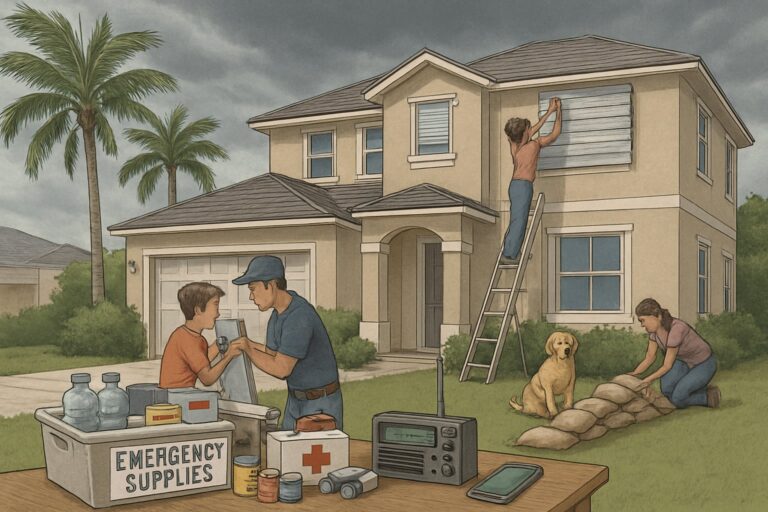

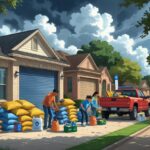

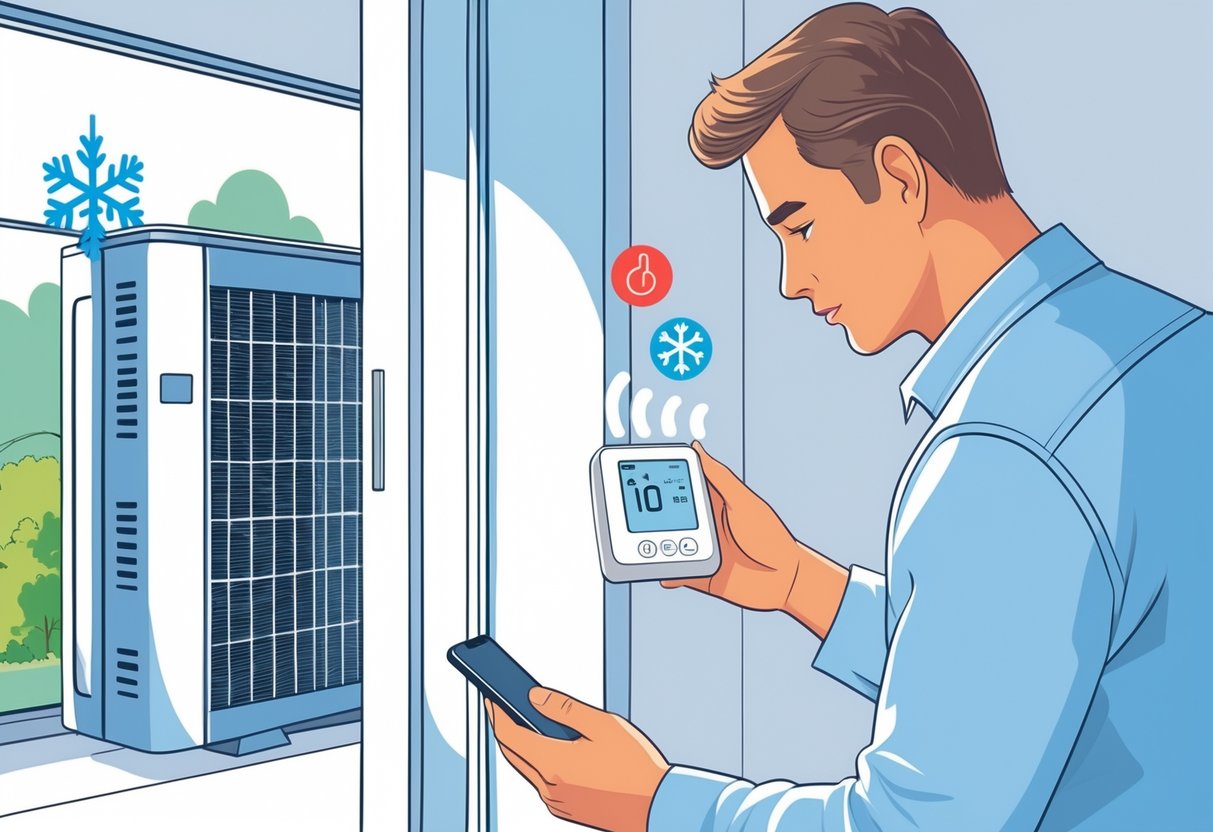
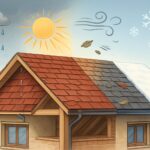
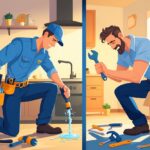
Leave a Reply